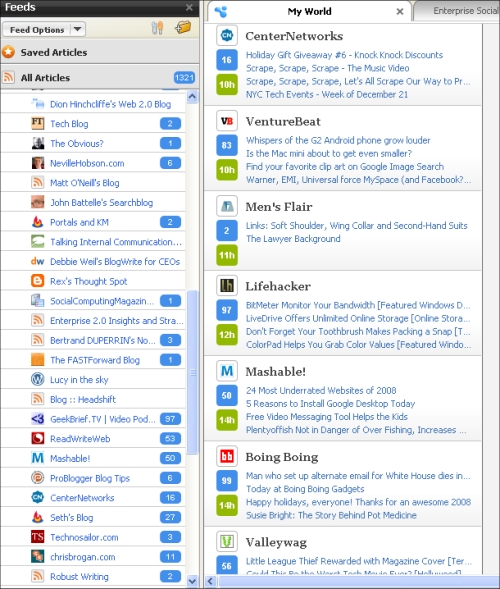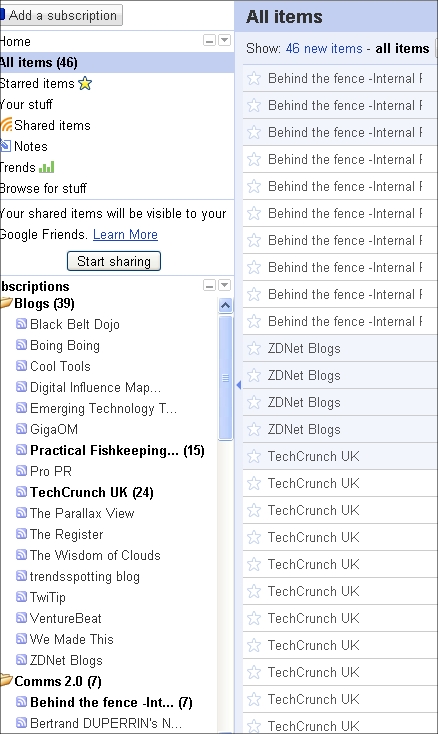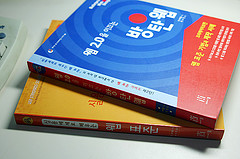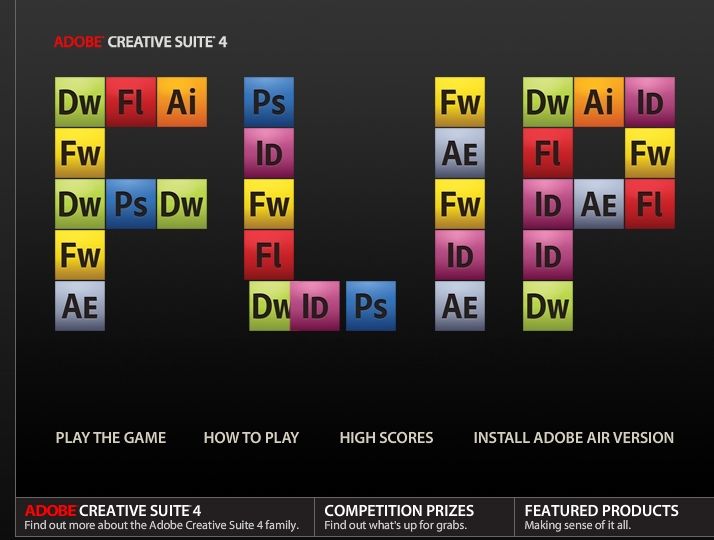- 42+ Social Media and Content Marketing Predictions for 2009 42 clever Bloggers
- The Future of Virtualization: Six Predictions Clouds take off
- Top 10 Cloud Computing Predictions for 2009 Clouds of Clouds make even more clouds
- 3DWeb Environments Corporations dabble, go mobile and we all get lost in 3D
- Social Media Predictions 2009 Twitter compilation
- eMarketer’s Predictions for 2009 Consolidation, multiculturalism and the same old same old
- Social Media in 2009: Our Predictions and Desires Crunch squeezes the tosh
- 15 Predictions for 2009 Puts the balls into crystal
- 2009 Trends and Predictions from the Editors of Consumer Guide to Plastic Surgery Bottoms up
- Five tech predictions for 2009 inc BBC a winner, Google a surpriser & Crunch crunches
- 10 eBay Predictions for 2009 Utter tosh!
- Enterprises will figure out how to use social networks in the right way Employers get as wise as their employees
- 8 Experts Predict How Web 2.0 Will Evolve In 2009 8 whole interweb gurus read their tea leaves
& The Parallax View’s winner so far this 2008: - Half a dozen consumer trends for 2009 Nichetributes, Luxyoury, Feedback 3.0, Econcierge, Mapmania & Happyending
Month: December 2008
Price of Spam
Reports in from Australia and New Zealand plus that august journal The Register, of a court case against one Lance Atkinson. You may have heard of him as he’s one of the chaps behind millions spam mails offering to augment appendages under such brands as Herbal King, Elite Herbal and Express Herbal, all made and shipped by Tulip Lab of India.
But how much spam did the spammer actually send out? The Sydney Morning Herald says it’s in the billions mark and cites the US Federal Trade Commission (FTC):
…allegedly controlled a “botnet” of 35,000 computers, capable of sending 10 billion email messages a day.
Atkinson’s fine for all this is the Register tells us, is $92,715 (about US $63,400). Infonews in New Zealand put it at $100K but which ever, all of which pales compared to the $2.2M USD he caught fined in 2005. But, being a good egg and of good character Lance got off lightly in any event:
The maximum penalty provided in the UEM Act for an individual is $200,000 but Justice French said Lance Atkinson was entitled to a substantial discount because of his co-operation and candour with authorities at an early stage, his undertaking to comply with the Act and the fact that the spamming began before it became illegal. (Infonews)
All a paltry drop etc when compared with the volume. None the less, according to Voxy in Kiwiland the Internal Affairs anti-spam compliance unit is celebrating:
The negative effects of spam are significant and far reaching and it’s pleasing to know there’s at least one less spammer plaguing the internet.
Too right, one less…one less.
Adobe Air Flip Flop
 One would think that available domains would be considered when making a choice such as Adobe Air – http://www.adobeair.com/
One would think that available domains would be considered when making a choice such as Adobe Air – http://www.adobeair.com/
 And as for Adobe Air, they should try their web page in Chrome…
And as for Adobe Air, they should try their web page in Chrome…
For those after the Adobe Air Flip site…
 Very good post from Lilia Efimova on Blogs – Publishing vs. Interaction: blog networking study: publishing vs. interaction
Very good post from Lilia Efimova on Blogs – Publishing vs. Interaction: blog networking study: publishing vs. interaction
Elia argues that Blogs are a hybrid between the 2, allowing the means to communicate and interact simultaneously:
Blogging as personal publishing is about broadcasting to broad and often unknown audiences allowing efficient communication, while blogging as interaction is about engagement with specific others that builds shared understanding and enables bonding. While those two functions result in positioning blogging as a hybrid genre….
Hybridity is one of those sticky terms that will for me be always associated with Post-colonialism and writers such as Homi Bhabha, Stuart Hall, Gayatri Spivak, and Paul Gilroy. This concept in Blogs is one to ponder as I think there’s a rich seam of information and sociality present…
Hybridity on Wikipedia
Adobe Air Flip
 An amusing article in the Sunday Times on a proposed bionic sex chip. According to the article scientists at Oxford University hope that within 10 years they’ll be able to implant a chip right into the pleasure cortex of the brain. Xmas 2018 looks sorted then.
An amusing article in the Sunday Times on a proposed bionic sex chip. According to the article scientists at Oxford University hope that within 10 years they’ll be able to implant a chip right into the pleasure cortex of the brain. Xmas 2018 looks sorted then.
However, early experiments have brought a mixed response:
A few years ago a scientist implanted such a device into the brain of a woman with a low sex drive and turned her into a very sexually active woman. She didn’t like the sudden change, so the wiring in her head was removed.
One of the key players in the field is Morten L. Kringelbach who has ‘hedonics’ as his main research area. A quick Google will reveal that hedonics stems from hedonism and studies pleasure. One can only boggle at Morten’s research practices.
Hedonics is also associated with Michael Eysenck (son of Hans Eysenck of IQ fame) who coined the term the “hedonic treadmill”. This dictum basically states that no matter what happens we basically stay at the same level of glumness. Here’s Wikipedia’s potted definition:
The tendency of a person to remain at a relatively stable level of happiness despite a change in fortune or the achievement of major goals. According to the hedonic treadmill, as a person makes more money, expectations and desires rise in tandem, which results in no permanent gain in happiness.
Now as I recall this theory relates to the happiness gained from say getting a new commodity such as a car, which lasts for about 6-8 weeks. After that it becomes the norm. The question then becomes, would the same happen with the bionic sex chip? Would one be ecstatically chuffed for 2 months and then get bored? Or would it take longer, say a 7 year itch? More to the point, will Oxford Uni be after new volunteers for their experiments? But what if they define it’s gone wrong and the volunteers don’t mind – would they have the right to continue on regardless?
Flock vs. Chrome : RSS
 So far Flock beats Chrome hands down when it comes to RSS reader. In fact Flock beats all players when it comes to RSS. Not sure what it is about Flock’s built in reader but it just seems to work so well. It runs as a sidebar amongst all the other social media functionality that Flock provides and the integration with the actual feeds and their web pages is as seamless as any I’ve seen. For me it’s the number one reason for using Flock as I’m underwhelmed by the rest of the social media apps it hosts – sometimes they work and other times they don’t and I’ve never got the WordPress one to function correctly.
So far Flock beats Chrome hands down when it comes to RSS reader. In fact Flock beats all players when it comes to RSS. Not sure what it is about Flock’s built in reader but it just seems to work so well. It runs as a sidebar amongst all the other social media functionality that Flock provides and the integration with the actual feeds and their web pages is as seamless as any I’ve seen. For me it’s the number one reason for using Flock as I’m underwhelmed by the rest of the social media apps it hosts – sometimes they work and other times they don’t and I’ve never got the WordPress one to function correctly.
 Chrome’s RSS reader is completely web based and while it looks a bit like Flock’s it’s way off on functionality. In fact it looks a bit like a beta. This is a shame as I like Chrome’s slickness. Adding a feed and then making sure it’s added to the right place is much more difficult that Flock. Navigation both between feeds and in the feeds themselves is also a bit flakey.
Chrome’s RSS reader is completely web based and while it looks a bit like Flock’s it’s way off on functionality. In fact it looks a bit like a beta. This is a shame as I like Chrome’s slickness. Adding a feed and then making sure it’s added to the right place is much more difficult that Flock. Navigation both between feeds and in the feeds themselves is also a bit flakey.
My vote is 8/10 for Flock and RSS with 4/10 for Chrome. A lot more work needed with Google’s offering.
 The last post on Spinning Mule 2.0 was originally posted last week but I thought it a bit OTT so saved the HTML and deleted it. I’ve now done a repost and made a note to trust my judgement a bit more in future. The reason for that is the arrival of a nice little number from Forrester called: “Innovating Strategic Management Paradigms And Models To Thrive Amid Global Change.”
The last post on Spinning Mule 2.0 was originally posted last week but I thought it a bit OTT so saved the HTML and deleted it. I’ve now done a repost and made a note to trust my judgement a bit more in future. The reason for that is the arrival of a nice little number from Forrester called: “Innovating Strategic Management Paradigms And Models To Thrive Amid Global Change.”
The report bandies about some dandy terms such as ‘Globalization 2.0? ‘Invisible IT’ and ‘Technology Populism’. By these they refer to the truly global market and the increasing impact, influence and importance of the BRIC economies; the evolution of IT into a ubiquitous business technology; and the fact that rather than the military it’s now the Facebook generation, i.e ordinary tech-savvy punters who are driving change.
To survive in this new world, Forrester recommend something that caught my eye – they recommend that corporations adopt what I’ve always thought as the prime mantra of internal comms, namely align whatever and all you do to the business strategy.
Strategic management paradigms are the über-approaches that: combine several discrete activities under one umbrella; have a direct and complex impact on a company’s strategy setting; and require comprehensive implementation efforts. Examples of strategic management paradigms include the core competency concept or the management by objectives (MBO) approach, which emanated from the academic world.
To back this up and to validate it for good or ill they say a measurement system is needed, such as SWOT, Balanced Scorecard and Six Sigma. What follows however takes an increasingly 2.0 twist – old business paradigms need to take the tectonic social media shift.
 The focus then should be on a customer-centricity. These they argue becomes part of a Business Transformation model. This transformation is one not only about organizing and behaving to meet customer needs, it’s also about adopting social media technology and practices to foster innovation and to adapt in agile fashion to meet new and evolving customer needs and desires.
The focus then should be on a customer-centricity. These they argue becomes part of a Business Transformation model. This transformation is one not only about organizing and behaving to meet customer needs, it’s also about adopting social media technology and practices to foster innovation and to adapt in agile fashion to meet new and evolving customer needs and desires.
 Will this happen? Forrester note the huge challenges present. I think this is the rub. Also there’s not a lot of choice. Global market, increased competition, global skills market, next gen 2.0 employees expect at least the very basics of what they use at home and at leisure. This opens up the market – opportunities as much as threat. The game is being completely re-written. We’re in a Crisis phase at present, but as the Chinese note, this is both Danger and Opportunity
Will this happen? Forrester note the huge challenges present. I think this is the rub. Also there’s not a lot of choice. Global market, increased competition, global skills market, next gen 2.0 employees expect at least the very basics of what they use at home and at leisure. This opens up the market – opportunities as much as threat. The game is being completely re-written. We’re in a Crisis phase at present, but as the Chinese note, this is both Danger and Opportunity
While traditional IT service providers can rejoice in the fact that their contributions will gain in importance, they can’t become complacent, as the new game represents an opportunity for entrants that excel in both strategy and technology. As a result, Forrester foresees active consolidation in the consulting and IT industries over the next five years.
 An excellent post from Bertrand Dupperin on the future of E 2.0: Enterprise 2.0 : my predictions for 2009. One item stood out and that was:
An excellent post from Bertrand Dupperin on the future of E 2.0: Enterprise 2.0 : my predictions for 2009. One item stood out and that was:
The end of “soft value” : Enterprise 2.0 ROI have been a taboo subject for a long time.
Over at Bill Ives’ Blog, there’s a review of an IBM report on Social Media –Even More Research on the Use of Social Software in the Workplace from IBM. Bill says the next step is the hard $ question and we need to:
…see if there are ways we can tie these behaviors [behavioral ones] to level four financial impacts. I feel confident that this can be done.
 I don’t think it’s going to be easy. If we go down the route of hard-cost savings then it potentially loses the richer benefits of social media which are much less harder to measure. IBM looks at the engagement factor by looking at societality, the element that interests me though is the degree to which E2.0 is a business enabler and a business transformer. Engagement might be measured in churn or satisfaction,even in increased profitability for the business, but E2 as business transformation provides more.
I don’t think it’s going to be easy. If we go down the route of hard-cost savings then it potentially loses the richer benefits of social media which are much less harder to measure. IBM looks at the engagement factor by looking at societality, the element that interests me though is the degree to which E2.0 is a business enabler and a business transformer. Engagement might be measured in churn or satisfaction,even in increased profitability for the business, but E2 as business transformation provides more.
That more is the Mule effect…It’s an effect that will be measured after the event, by profound competitive advantage. That’s why there’s an edge to E2.0, time is of the essence. 2.0 may well dissolve into the enterprise as Bertrand believes, but those that get there 1st will be the winners. The laggards will be like those handloom weavers who in a generation moved from sporting £5 notes in their hats to, well, utter destitution. This may seem apocalyptic, but then we’re in uncharted times, with seemingly ‘timeless’ brands suddenly realising their mortality. E2.0 will only quicken that process.
Chiswick man’s global feast
 Great story about Andy Hayler on the Chiswick W4 website (pronounced Chizik). He’s a local chap who has eaten in every single 3 Star Michelin restaurant in the world!
Great story about Andy Hayler on the Chiswick W4 website (pronounced Chizik). He’s a local chap who has eaten in every single 3 Star Michelin restaurant in the world!
Rather tasty website from the man himself too, and the Grauniad list it as one of the Top 10 restaurant sites in the world.

